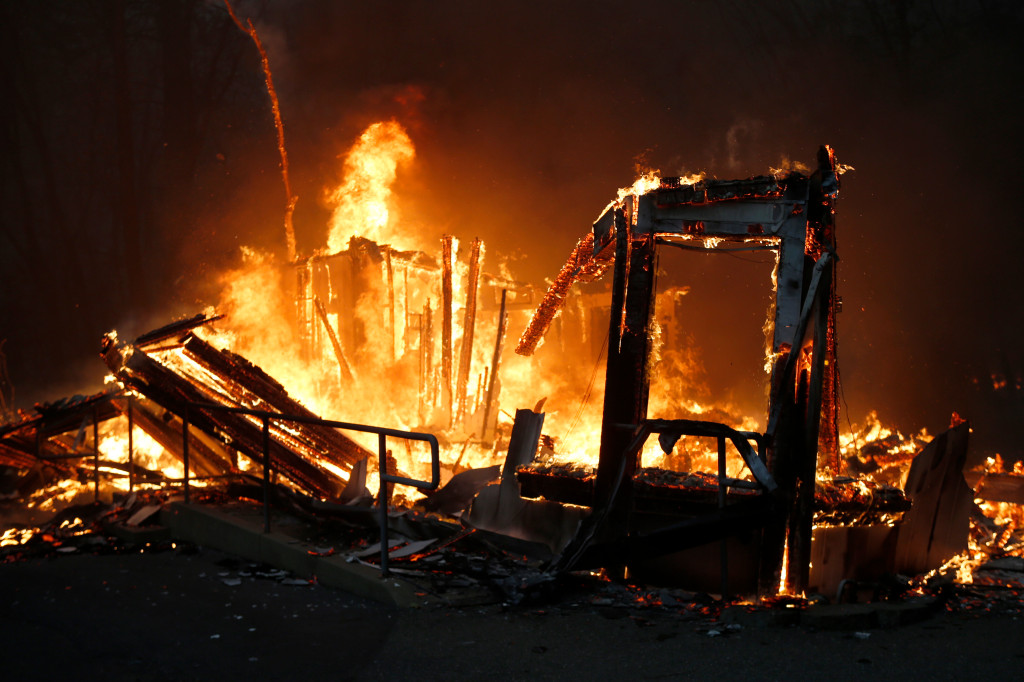The fast-moving Camp Fire caused traffic gridlock as Butte Country residents tried to evacuate Thursday, leading some of them to abandon their vehicles as the fire grew closer to the roadways.
Had the now-deadly fire been detected earlier and officials been able to give more notice, some residents might have avoided the dangerous situation of such a narrow escape.
How far can technology go to help automatically detect and even predict wildfires? From coast to coast, computer scientists, researchers and others are working on pushing for as far as possible.
Early detection is key as wildfires have gotten worse in recent years, according to Jim Crawford, assistant chief of South Bay operations for Cal Fire’s Santa Clara unit, who has been a firefighter for 26 years.
“The job I signed up for 26 years ago is not the same job today,” he said. “In the 1990s, firefighters battled a normal large fire for a couple of weeks. Any more than that was considered a ‘career fire.’ Now we’re having career fires multiple times a year.”
The Camp Fire — which as of Thursday night had burned more than 20,000 acres and destroyed thousands of structures — is one of more than 5,500 wildfires that have burned more than 640,000 acres in California so far this year.
Fire agencies mostly find out about fires from 911 calls — which is what happened with the Camp Fire, according to Cal Fire Capt. Scott McLean. They also monitor cameras placed throughout the state, including on undisclosed Bay Area mountaintops. Some of the cameras are aided by detection algorithms and satellites, but the systems are not quite real-time and the resolution could be better, experts say.
“Lots of people are looking into using artificial intelligence to figure out fire location, spread and behavior,” said Craig Clements, associate professor at the Fire Weather Research Laboratory for the Department of Meteorology and Climate Science at San Jose State University.
For example, there’s the Geostationary Operational Environmental Satellite (GOES) Early Fire Detection System, a collaboration between the Center for Spatial Technologies and Remote Sensing (CSTARS) at UC Davis and the U.S. Forest Service. It uses National Oceanic and Atmospheric Administration weather satellites and fire-detection algorithms.
CSTARS scientist Alex Koltunov, who has a Ph.D. in remote sensing, has been working on and off on the system’s algorithms — sets of rules programmed to perform calculations or carry out certain tasks — for the past several years, with the goal of optimizing data processing to help detect ignitions as early as possible.
He and his colleagues have been using GOES-15, a satellite that was launched in 2010, to conduct testing using past images and wildfire-incident reports over many states to help fine-tune the algorithm, which he hopes to one day apply to GOES-16 and GOES-17. Those satellites, launched in the past couple of years, can provide higher-resolution images “every 5 minutes or sometimes every minute,” Koltunov said. Higher-resolution images should allow firefighters and others to detect wildfires more quickly and accurately.
But he pointed out that no single tool can be a “silver bullet” when it comes to detecting wildfires.
“Each method has its limitations,” Koltunov said. When it comes to algorithm-based detection, for instance, “how good is the data? Is the fire a barbecue in a backyard, or a campfire? Some clouds can be confused with wildfires, too.”
Crawford from Cal Fire also stresses that technological advances are just one tool. It takes partnerships: Humans, machines, government agencies, utilities and other parties all working together to detect and fight fires from the ground, air and space.
“The cellular phone has become the most important tool for us,” Crawford said, since most fire notifications come from 911 calls. But he said there continue to be human “lookouts” who are perched on mountains or in towers to help alert authorities, especially in rural areas, and at places such as Lick Observatory at Mount Hamilton near San Jose during times of high fire danger.
In addition, Forest Service employees armed with infrared sensor systems fly over active wildfires at night. The information collected is used in maps many Californians have become familiar with by now — the ones that show exactly where wildfires are burning.
Meanwhile, a computer engineer at NASA Goddard in Virginia has tested a neural network — a machine-learning tool meant to mimic the human brain — that can detect wildfires using MODIS, which is a satellite-based system that takes photos of the Earth and transmits data for use in things such as weather forecasting. James MacKinnon hopes the system can eventually lead to automatic wildfire detection, he said during a presentation to a group of reporters recently at NASA Goddard.
He found the system, for which he used a year’s worth of fire data from around the world, to be nearly 98 percent accurate in detecting fires, he said in a subsequent phone interview. But such a system — which he hopes could involve sending inexpensive satellites to space for the sole purpose of fire detection, and combining that with neural networks that are “really great at finding patterns” — could be years away.
MacKinnon is looking for NASA scientist collaborators who can help draft a proposal, and hopes that his system could be deployed in the next several years for use by emergency responders. His ultimate goal: “Detection is one thing, forecasting is another thing. Can we eventually say there’s fire coming in a few hours?”
Crawford is all for technological advances that can help emergency managers and responders. Both the CSTARS system and the NASA system aim to send the information they collect directly to firefighting agencies.
“Having tools that can give us great situational awareness and an overview of a region will help managers make better decisions,” he said. “I can’t build a (firefighting) plan until I know what I have.”









